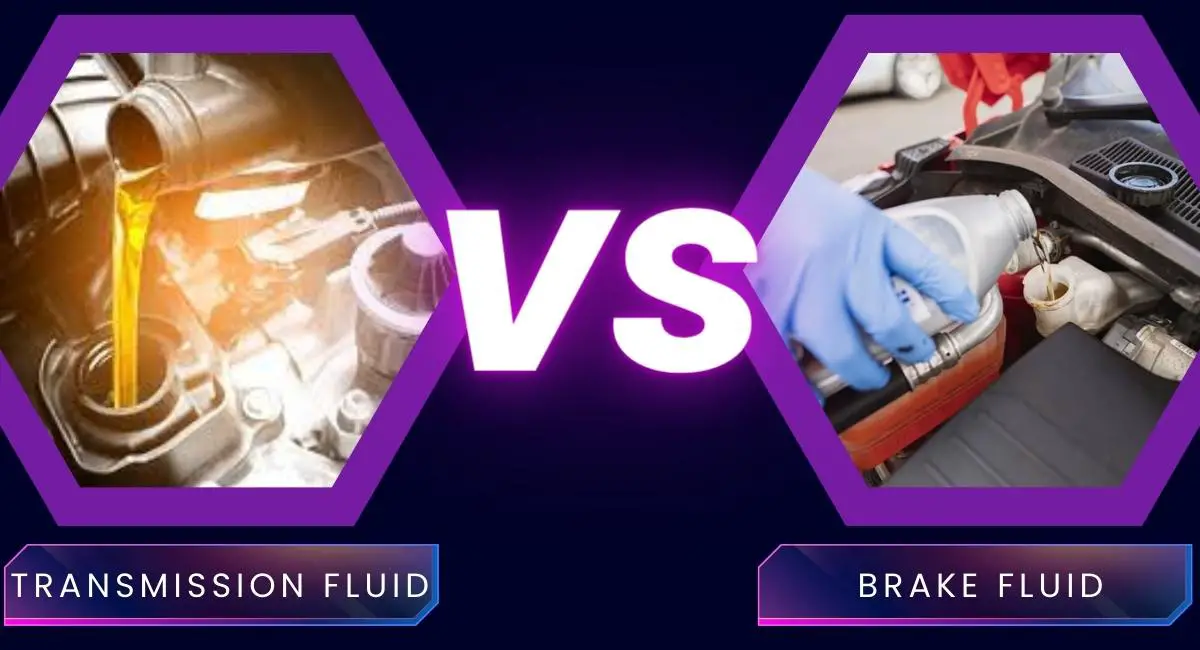Are you preparing for an adventurous road trip, or have you been using your car without keeping tabs on the fluids? If not, then you should. The braking and transmission systems are essential components of your car’s functioning.
Transmission fluid is a lubricant for automatic transmission, while brake fluid plays a crucial role in transmitting the force from your brake pedal to all four corners of your vehicle. It’s essential to understand that these two fluids are distinct, and you cannot use them interchangeably.
This article comprehensively explores the differences between brake fluid and transmission fluid to help you in car maintenance processes. It involves the following topics:
- Distinguish transmission fluid and brake fluid
- What to do if you accidentally add transmission fluid to the brake system.
- What happens when you add brake fluid to the transition fluid
- DIY steps for removing wrongly mixed fluids from the car system
- Maintenance of transmission fluid and brake fluid

Distinguishing Brake Fluid Vs. Transmission Fluid
If you’re new to the motor world, messing up or mixing the transmission and brake fluids is easy. Yet fixing a messed up car today is more costly than years ago. But we’re here to help you better distinguish transmission from brake fluid. So, is transmission fluid the same as brake fluid? Let’s find out:
Functionality and Purpose
Transmission fluid, as the name suggests, is specifically designed to lubricate and cool your vehicle’s transmission system. It acts as a hydraulic fluid facilitating smooth gear shifting and power transmission from the engine to the wheels. Its formulation can withstand high temperatures and pressure.
Brake fluid, on the other hand, serves a different purpose entirely. Its primary role is to transfer force from the brake pedal to the brake components (calipers or wheel cylinders) to initiate braking. Brake fluid is a hydraulic fluid that must maintain a consistent viscosity even at extreme temperatures.
Chemical Composition
Transmission fluid is typically composed of base oils, additives, and detergents. It may contain friction modifiers and anti-wear additives to protect transmission components. Automatic transmissions often use different types of transmission fluids compared to manual transmissions.
Brake fluid is predominantly composed of glycol-ether or silicone-based compounds. It is specially formulated to be non-compressible and has a high boiling point to withstand the heat generated during braking. These chemicals make them suitable for the brake system’s demanding requirements.
Can You Use Transmission Fluid for Brake Fluid?
Using transmission fluid instead of brake fluid is like trying to fit a square peg into a round hole—it simply doesn’t work. These two fluids might play essential roles in your vehicle but are as different as night and day. It’ll not only fail to do the job but can lead to catastrophic consequences.
Here’s what happens when you use transmission fluid as an alternative to brake fluid:
- Brake systems operate at high temperatures, and transmission fluid design cannot handle these conditions. When used in the brake system, it can lead to brake fluid boiling, reduced braking efficiency, and complete brake system failure.
- Transmission fluid can damage rubber seals and hoses in the brake system, leading to leaks and loss of brake fluid. Contaminated brake fluid can compromise braking performance and safety.
- Using transmission fluid in the brake system can jeopardize your safety and the safety of others on the road. It can result in reduced braking power, longer stopping distances, and an increased risk of accidents.
- Repairing a brake system contaminated with transmission fluid can be expensive. It may require replacing damaged components, flushing the system, and bleeding the brakes.
So, when it comes to your car’s fluids, remember: transmission and brake fluid might share the stage, but they sure don’t share the spotlight!
What to Do If You Accidentally Add Transmission Fluid to the Brake System
Despite the warning on how dangerous it could be when you add transmission fluid to brake fluid, you mistakenly added. Now, you must ensure the safety and effectiveness of your car. Take the following immediate actions:
- Do not drive the vehicle; the risk of brake failure is too significant.
- Have the car towed to a qualified automotive repair shop or dealership.
- They will need to flush and clean the entire brake system thoroughly.
- Depending on the extent of the contamination, you may need to replace some vehicle components, including hoses, seals, and the master cylinder.
But before towing your car or getting help from the dealership, you may try the following easy steps.
DIY Steps on Draining Transmission Fluid from the Master Cylinder
After the mix-up, stay calm and halt any actions related to your vehicle. Do not touch the brake pedal; ensure no one else can push it down. This step is crucial to prevent further mixing of the fluids and potential damage to your brake system. Then,
- Considering all safety precautions, ensure the vehicle is on a level surface and secure.
- Use a syringe or similar tool to remove as much of the contaminated brake fluid as possible from the brake reservoir.
- Thoroughly clean the brake fluid reservoir to eliminate any remaining traces of the mixed fluid. Wipe it clean to ensure no residue is left behind.
- Fill the reservoir with fresh, clean brake fluid specified for your vehicle.
- To ensure that all traces of transmission fluid are gone, repeat the process of adding brake fluid and then suctioning it out. Continue until you are confident that only clean brake fluid remains in the system.
- Once you are sure that only brake fluid remains in the system, reassemble all components, including a new master cylinder, if necessary. Proceed to bleed your brakes following the standard brake bleeding procedure to ensure the system is free of air bubbles and functions correctly.
What if you pressed the brake pedal unintentionally and introduced transformation fluid into the brake system? No need to fret; the solution is to replace all four calipers, replace all the rubber hoses, install a new proportioning valve, and swap out the hydraulic pump. Remember to perform a thorough steel line flush using acetone.
What Happens When You Add Brake Fluid to the Transmission Fluid?
Adding brake fluid to the transmission oil is a severe mistake that can harm your vehicle’s transmission system. The consequences of such an error are as follows:
The Brake fluid design is not for a transmission system’s lubrication and cooling requirements. When mixed with transmission oil, it can lead to reduced lubrication and cooling capabilities, potentially causing excessive wear and overheating of transmission components.
In vehicles with manual transmissions, the clutch components and seals can be particularly vulnerable to the corrosive properties of brake fluid. It can result in clutch slippage, poor gear engagement, and potential seal leaks.
Mixing brake fluid with transmission oil can lead to decreased transmission performance, including rough shifting, gear slipping, and difficulty maintaining proper gear engagement.
Brake fluid is hygroscopic, readily absorbing environmental moisture. This moisture can further contaminate the transmission fluid, leading to even more significant issues over time.
How to Remove Brake Fluid from Transmission Fluid in Your Car
While fixing the brake system issues is easy, removing brake fluid from the transmission system is nearly impossible without help. For instance, certain automakers, like Volkswagen, demand costly scan tools to ensure the transmission operates under specific conditions, making DIY checks practically impossible.
So, when there is a mix-up, seek professional help. But first;
Avoid operating the vehicle further. Driving with contaminated transmission oil can exacerbate the problem and potentially lead to more severe damage.
Unlike the process for brake fluid in the brake system, it is not advisable to attempt to flush or drain the transmission fluid yourself in this situation. Transmission systems are complex, and improper handling can lead to further complications.
So, contact a qualified automotive technician or a transmission specialist immediately. They will have the expertise and tools needed to assess the extent of the damage and take appropriate corrective actions.
The technician may need to perform a transmission flush to replace the contaminated fluid with the correct transmission fluid. This process requires specialized equipment and knowledge to ensure the transmission is adequately cleaned and refilled.
Besides, ensure the technician replaces severely damaged transmission components, such as the clutch or seals. After resolving the issue, adhering to regular transmission maintenance schedules and avoiding mixing fluids in the future is crucial.
Maintenance of Transmission Fluid vs. Brake Fluid
Regular transmission and brake fluid maintenance ensures your vehicle’s safe and efficient operation. While both transmission and brake fluids are essential for your vehicle’s operation, their care differs in inspection intervals, fluid replacement frequency, and specific requirements.
Transmission Fluid
Check your vehicle’s owner’s manual for recommended transmission fluid change intervals. IT typically ranges from 30,000 to 60,000 miles but can vary by make and model.
Pay attention to fluid color and odor. If the transmission fluid is dark, discolored, or has a burnt smell, it may be time for a change.
Have your transmission fluid replaced by a qualified mechanic, or follow a DIY guide if you have the necessary tools and expertise. Unlike brake fluid, transmission systems are complex, and it is impossible to replace the fluid yourself.
Brake Fluid
Brake fluid should be inspected during routine vehicle maintenance, typically when you change your oil or service your brakes.
Brake fluid replacement intervals vary by vehicle, but a standard recommendation is every two years. Check your owner’s manual for specific guidelines.
Important Read: Understanding VSA Light and Jerks When Accelerating
If you notice that your brake fluid is discolored or contaminated, it’s crucial to have it replaced promptly. Its hygroscopic nature necessitates frequent replacement to prevent moisture-related issues and ensure optimal braking performance.
In Summary
Transmission fluid, the lifeblood of your transmission system, keeps gear shifts smooth and reduces friction. On the other hand, brake fluid is the hydraulic force behind your vehicle’s stopping power. Consider their regular maintenance as integral to your vehicle’s operation. Besides, knowing their differences and adhering to proper care procedures will provide a smoother, safer, and more reliable driving experience. Always consult your owner’s manual and seek professional guidance to ensure your vehicle’s fluids are in top condition.
